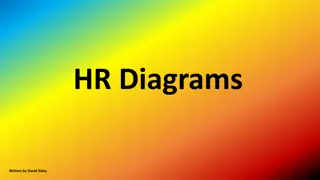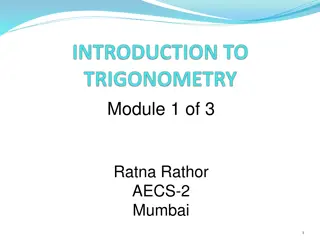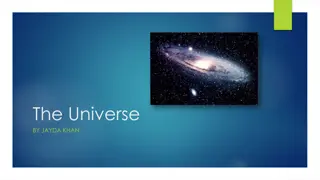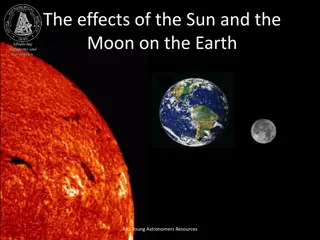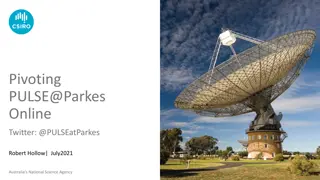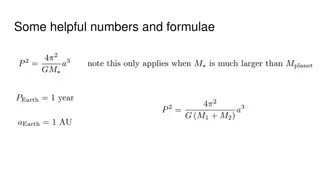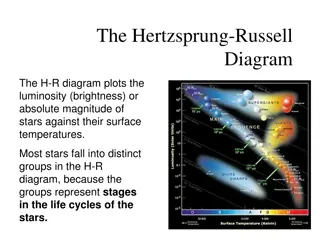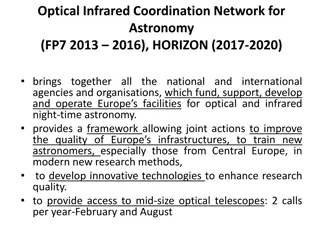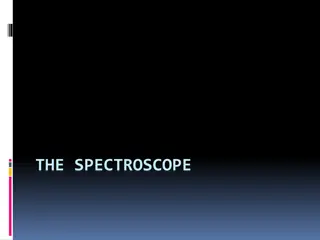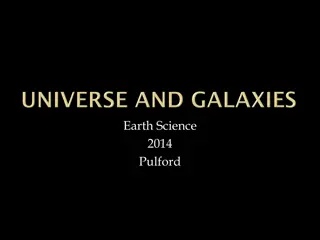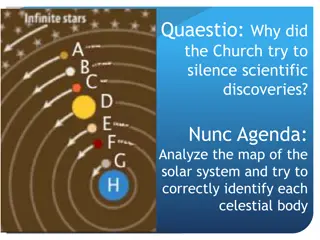Exploring Germanic Tribes and Languages in History
Delve into the ancient Germanic tribes and languages, their territories, movements during the Migration Period, surviving languages, writing systems, and encounters with prominent historical figures like Roman generals. Learn about the earliest mentions of Germans by Greek travelers and astronomers,
3 views • 35 slides
Understanding HR Diagrams in Astronomy
HR diagrams, named after astronomers Hertzsprung and Russell, depict stars' properties and relationships. The main sequence in the diagram shows where stars lie while fusing hydrogen to helium in their core. Learn about different types of stars and their positions on the diagram. Explore the signifi
0 views • 27 slides
Indian Contributions to Science: Yesterday, Today, and Tomorrow
Explore the rich history of Indian contributions to science, from ancient mathematicians like Aryabhatta to modern-day astronomers like Madhava. Discover the evolution of trigonometry, algebra, and astronomy in India, showcasing the brilliance of minds over the centuries.
0 views • 10 slides
Journey Through the Cosmos: From Einstein's Theories to the Big Bang
Explore the evolution of our understanding of the universe, from Einstein's initial beliefs in a static cosmos to the groundbreaking discoveries of an expanding universe and the Big Bang theory. Witness how observations of galaxies moving away in all directions and the cosmic microwave background ra
0 views • 13 slides
Exploring Trigonometry: History, Applications, and Importance
Trigonometry, derived from Greek words meaning "three sides measure," is a vital mathematical discipline studying triangles' sides and angles. Delve into its historical significance, practical applications in real life, and foundational trigonometric ratios. Discover how ancient astronomers and math
0 views • 22 slides
The Evolution of the Universe: From Big Bang to Red Shift Analysis
The Universe, as we know it today, started with the Big Bang around 13.5 billion years ago, leading to the expansion of galaxies and the formation of stars, planets, and moons. Edwin Hubble's discovery of galaxies moving away from each other provided key insights into the expanding universe. Astrono
1 views • 13 slides
Understanding Human Contrast Threshold and Astronomical Visibility
Delve into the practical implications of human contrast threshold and astronomical visibility to explore the faintest stars visible to the naked eye or through telescopes under various lighting conditions. This study aids in comprehending the essence of dark skies, the historical evolution of light
0 views • 28 slides
Exploring Sun, Moon, and Earth: Resources for Young Astronomers
Discover the fascinating effects of the Sun and Moon on Earth, learn about the Sun-Earth-Moon system, explore the scale of these celestial bodies, understand the phases of the Moon, observe tides, uncover the reasons behind the four seasons, and watch educational videos on lunar phases and tides. Di
0 views • 9 slides
PULSE@Parkes: Engaging High School Students in Astronomy Education
PULSE@Parkes is a program where high school students collaborate with professional astronomers to conduct remote observations using the Parkes radio telescope. The program offers hands-on experiences, online modules, and data sessions for students in years 10-12. Students also have the opportunity t
0 views • 36 slides
Exploring Planet Nine: Orbits, Mass, and Kepler's Law
Astronomers speculate about Planet Nine, a massive body in the distant Solar System. Calculations are made about its orbit period, potential interactions with a black hole, and changes in period if it were more massive than the Sun. Utilizing Newton's version of Kepler's Law, astronomers delve into
0 views • 7 slides
Understanding Stars: The Hertzsprung-Russell Diagram and Stellar Properties
The Hertzsprung-Russell Diagram is a tool that plots the luminosity or absolute magnitude of stars against their surface temperatures, revealing distinct groups that represent stages in the stars' life cycles. Apparent magnitude measures how bright a star appears from Earth, while absolute magnitude
0 views • 16 slides
Fascinating Insights into Stellar Distances and Parallax Measurements
Delve into the vast distances between stars, such as Alpha Centauri and Proxima Centauri, captured through intriguing images. Explore the concept of parallax and its role in estimating stellar distances relative to our Sun. Understand the challenges astronomers face in measuring these immense distan
0 views • 7 slides
Riccardo Giacconi's Impact on Japanese X-ray Astronomy
Riccardo Giacconi played a significant role in Japanese X-ray astronomy, influencing the first generation of X-ray astronomers in Japan and contributing to the development of X-ray telescopes. His visits and collaborations with Japanese scientists, such as Hideyo Kunieda and Yasuo Tanaka, were instr
0 views • 8 slides
Optical Infrared Coordination Network for Astronomy (FP7 2013-2016), HORIZON (2017-2020)
This network consolidates funding and support for Europe's optical and infrared astronomy facilities, aiming to enhance infrastructure, train new astronomers, and develop cutting-edge technologies. It emphasizes collaboration among national and international agencies, optimizing access to mid-size t
0 views • 20 slides
Exploring the World of Spectroscopy and the Electromagnetic Spectrum
Spectroscopy is a crucial tool for astronomers to analyze the composition of objects in space by separating light into its constituent colors. Each chemical element has a unique spectral fingerprint that helps in identification. The Electromagnetic Spectrum provides a comprehensive view of different
0 views • 15 slides
Discovering the Universe: A Journey Through Space and Time
Astronomers explore the vast cosmos, classifying galaxies into Spiral, Elliptical, and Irregular types. Our solar system resides in the Milky Way, a massive spiral galaxy. The accepted theory of the Big Bang explains the universe's origin, supported by Edwin Hubble's observations. Delve into the mys
0 views • 17 slides
Evolution of the Heliocentric Model: Science vs. Church
The Church historically backed the Geocentric Model, placing Earth at the center of the universe based on biblical interpretations. However, trailblazing astronomers like Copernicus, Brahe, and Kepler challenged this notion by proposing the Heliocentric Model with the Sun at the center. This shift l
0 views • 18 slides
The Fascinating Story of Pluto's Discovery and Characteristics
Pluto, once considered the outermost planet, is located 6 billion kilometers from the Sun and has a fascinating history surrounding its discovery. From its extreme cold temperatures to the lengthy time light takes to reach it, Pluto continues to captivate astronomers and enthusiasts alike. Learn abo
0 views • 23 slides

